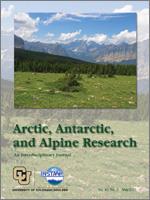Recent studies have revealed positive and negative trends in the radial growth of treeline white spruce (Picea glauca) as temperatures have warmed in recent decades. Investigators have speculated that negative growth trends reflect the increasing importance of temperature-induced drought stress, yet direct observations of drought-induced stomatal closure have not been made in white spruce near the Arctic treeline. In this study, we measured needle gas exchange, a variety of needle traits, and branch growth in contrasting growing seasons on a riverside terrace near the Arctic treeline in Noatak National Preserve, northwest Alaska. Needle gas exchange was limited by cold soils (<7 °C), nighttime frosts, large vapor pressure deficits (VPD) and/or low soil water contents during the majority of our midday measurements. Near optimal conditions for needle gas exchange were consistently found in late August, when soils were relatively warm, air temperatures were moderate, and the VPD was relatively small. Defoliation during a two-year bud moth infestation (Zeiraphera spp.) substantially reduced branch growth, obscured potential relationships between needle gas exchange and growth, and revealed the importance of whole canopy gas exchange measurements. Results of our study show there is a very narrow window of environmental conditions for near optimal needle gas exchange in white spruce near the Arctic treeline. Although we identified many abiotic constraints on needle gas exchange, a single biological factor likely had the greatest effect on annual branch growth.
How to translate text using browser tools
1 May 2011
Environmental Controls on Needle Gas Exchange and Growth of White Spruce (Picea glauca) on a Riverside Terrace near the Arctic Treeline
Patrick F. Sullivan,
Bjartmar Sveinbjörnsson





